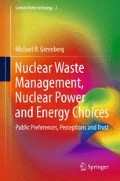Abstract
The primary challenges to the DOE, NRC, EPA, and contractors responsible for managing the defense and commercial nuclear waste legacies are technology and high cost. Yet given the long period that the waste must be stewarded, the responsible parties must invest in short-term and long-run programs to build mutually beneficial stable relationships that are able to withstand the stresses of technical mishaps and human disagreements and endure for many generations. This chapter suggests five key steps in light of the Fukushima events:
-
1.
Do not shoot the messenger. Fear needs to be acknowledged, not dismissed as irrational.
-
2.
If the audience wants to understand what happened in Japan, or in other incidents involving nuclear facilities, then engage in a discussion if you feel competent to do so, or try to find someone who can.
-
3.
People want the responsible parties to demonstrate ability to protect them, and prove through these actions that safety is the highest priority now and in the future.
-
4.
The public wants promises about definitive steps to improve safety, efficiency, and other metrics of competence; they want to know what communications will keep them or their representatives in the loop; and they want to be sure that the safety is not going to be sacrificed.
-
5.
Follow-through with promised actions. Trying to change public opinion with words not matched by deeds will erode, perhaps even poison, what could be a productive ongoing organizational relationship.
More detail is provided in the body of the chapter.
Access this chapter
Tax calculation will be finalised at checkout
Purchases are for personal use only
References
Arnstein S (1969) A ladder of citizen participation. J Am Inst Plann 35:216–224
Blue Ribbon Commission on America’s Nuclear Future (2012) Final Updated Report. http://brc.gov Accessed March 21, 2012
Burger J, Powers C, Greenberg M, Gochfeld M (2004) The role of risk and future land use in cleanup decisions at the Department of Energy. Risk Anal 24:1539–1549
Committee on Risk Perception and Communication, National Research Council, (1989) Improving risk communication. National Academy Press, Washington, DC
Connell J, Pickett D (2000) Land use controls on BRAC bases. ICMA, Washington DC
Covello V, Sandman P, Slovic P (1988) Risk communication, risk statistics, and risk comparisons: a manual for public managers. Chemical Manufacturers Association, Washington DC
Dietz T, Fitzgerald A, Schwom R (2005) Environmental values. Ann Rev Environ Resour 30:335–372
Environmental Health Center and National Safety Council (2001) A reporter’s guide to Yucca mountain. Washington, DC
Fischhoff B (1995) Risk perception and communication unplugged: twenty years of research. Risk Anal 15:137–145
Greenberg M, Lowrie K, Hollander J, Burger J, Powers C, Gochfeld M (2008) Citizen board issues and local newspaper coverage risk, remediation, and environmental management. Remediation. Summer; 79–90
Greenberg M, Lowrie K, West B, Mayer H (2009) The reporter’s handbook on nuclear materials, energy, and waste management. Vanderbilt University Press, Nashville, TN
Greenberg M, Truelove H (2011) Energy choices and perceived risks: is it just global warming and fear of a nuclear power plant accident? Risk Anal 31(5):819–831
Greenberg M, Mayer H, Powers C (2011) Public preferences for environmental management practices at DOE’s nuclear waste sites. Remediation 21:117–131
Huizenga D (2012) WM symposia 2012 and FY 2013 budget overview. Paper copy received March 15, 2012
ICMA (1996) Cleaning up after the cold war: the role of local government in the environmental cleanup and reuse of federal facilities. ICMA, Washington DC
Jenkins-Smith H, Silva C, Nowlin M, deLozier G (2011) Reversing nuclear opposition: evolving public acceptance of a permanent nuclear waste disposal facility. Risk Anal 31:629–644
Keller C, Visschers V, Siegrist M (2012) Affective imagery and acceptance of replacing nuclear power plants. Risk Anal 32:464–477
Leiserowitz A, Maibach E, Light A (2009) Global warming’s six Americas, Yale Project on Climate Change, http://www.americanprogress.org/issues/2009/05/6american.html. Accessed march 21, 2012
Lofstedt R (2005) Risk management in post-trust societies. Earthscan, London
Miller B, Sinclair J (2012) Risk perceptions in a resource community and communication implications: emotion, stigma, and identity. Risk Anal 32:483–495
Office of Environmental Management (2000) Paths to closure, status report. DOE/EM-0526
Persensky J, Browde S, Szabo A, Peterson L, Specht E, Wight E (2004) Effective risk communication, the nuclear regulatory commission’s guideline for external risk communication, NUREG/BR-0308. USNRC, Washington, DC
Probst K, McGovern M, McCarthy K (1997) Long-term stewardship and the nuclear weapons complex. RFF, Washington DC
Stern P, Fineberg H (eds) (1996) Understanding risks: informing decisions in a democratic society. National Academy Press, Washington DC
U.S. Department of Energy (2012) Department of energy: Successes at the Recovery Act, http://energy.gov/sites/prod/files/RecoveryActSuccess-January 2012. Accessed March 21, 2012
Wernstedt K, Hersh R (1997) Land use and remedy selection; experience from the field – the Fort Ord Site. Resources for the future, Discussion Paper, Washington DC, 97–128
Author information
Authors and Affiliations
Rights and permissions
Copyright information
© 2013 Springer-Verlag London
About this chapter
Cite this chapter
Greenberg, M.R. (2013). Nuclear Waste Management: Building a Foundation to Enhance Trust. In: Nuclear Waste Management, Nuclear Power, and Energy Choices. Lecture Notes in Energy, vol 2. Springer, London. https://doi.org/10.1007/978-1-4471-4231-7_6
Download citation
DOI: https://doi.org/10.1007/978-1-4471-4231-7_6
Published:
Publisher Name: Springer, London
Print ISBN: 978-1-4471-4230-0
Online ISBN: 978-1-4471-4231-7
eBook Packages: EngineeringEngineering (R0)

